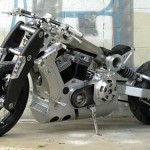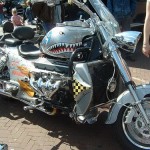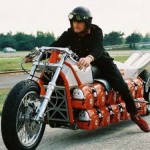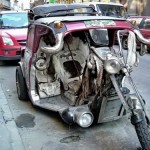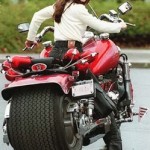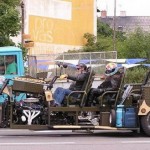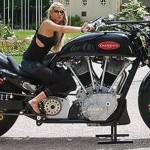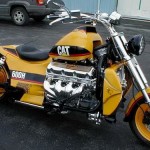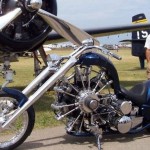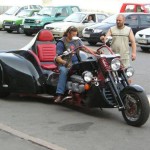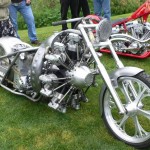Here is a motorcycle from the past. For you motorcycle enthusiasts. This is something that many of us have never seen or heard of.
Victory has now begun producing Police Motorcycles.
They are located at:
1102 N. Anita Avenue
Tucson, Az. 85705
770-9500
For more information: Victory Motorcycles
The following release is from the AMA…
Federal action to allow more ethanol in gasoline could damage motorcycles
PICKERINGTON, Ohio — The U.S. Environmental Protection Agency has agreed to allow the ethanol portion of blended gasoline to be increased from the current 10 percent to 15 percent for certain vehicles, which could pose a danger for motorcycles, the American Motorcyclist Association (AMA) reports.
On Oct. 13, the EPA announced approval of a waiver for E15. Under the decision, E15 is now approved for use in model year 2007 and newer cars and light trucks. It isn’t approved for use in any other gasoline-fueled engines. To see the EPA news release, go to http://tinyurl.com/US-EPA-E15.
“The AMA supports the use of cleaner-burning fuels, but we are concerned that gasoline containing more than 10 percent ethanol could result in premature engine damage or failure while a motorcycle is being ridden,” said Imre Szauter, AMA government affairs manager. “We’re also concerned about any degradation in performance, fuel economy and rideability that may result from the long-term use of blended fuels with greater than 10 percent ethanol.”
The EPA, in allowing more ethanol in gas, specifically said that its decision covers model year 2007 and newer cars and light trucks, and no other vehicles at this time, including motorcycles.
“Motorcycle manufacturers only certify their machines to run on gasoline or a blend with up to 10 percent ethanol, which is known as E10,” Szauter said. “So using the 15 percent blend in a motorcycle could void the bike’s warranty.”
Growth Energy, an ethanol lobbying group, asked the EPA in March 2009 to allow gasoline to contain up to 15 percent ethanol. It’s part of an effort to meet a congressional mandate to increase to 36 billion gallons the amount of renewable fuel available in the United States by 2022. Ethanol, made from corn and other crops, is considered a renewable fuel.
For more than three years the AMA has been on the record opposing increases in the ethanol level allowed in gasoline until studies show that an increase won’t damage motorcycle or all-terrain vehicle (ATV) engines, and won’t make motorcycles emit more nitrogen oxides than are allowed by the EPA.
“The message we want to deliver today is that once E15 gas is offered for sale, there are a variety of reasons not to put it in your motorcycle or ATV gas tank,” Szauter said. “In fact, the EPA even says you aren’t allowed to put E15 in your bike.”
The EPA said a decision on the use of E15 in model year 2001 to 2006 vehicles will be made after new test results are received. The EPA is also proposing E15 pump labeling requirements so that consumers don’t mistakenly put E15 in the wrong vehicles.
Bob Greco, spokesman for the American Petroleum Institute, told The Wall Street Journal that by approving E15 without full testing, the EPA is putting “politics before science.”
“You’re going to have fuels in the marketplace that could damage engines and void warranties,” Greco told the newspaper.
The AMA is a member of AllSAFE, the Alliance for a Safe Alternative Fuels Environment, a group formed to ensure that fuels containing ethanol are promoted in a thoughtful manner. AllSAFE is made up of associations that represent consumer and commercial users of ethanol blends, manufacturers of boats, vehicles, engines and equipment, and retailers who sell gasoline and ethanol-fuel blends.
In the last entry we saw that ordinary people in ordinary circumstances misjudge the actual ability of protective gear to reduce or prevent injury and take on more risk that uses up that safety margin. Motorcyclists are just as likely to fall prey to risk compensation as others. But how do motorcyclists—and non-riders—come to have an exaggerated belief that helmets, specifically, are more effective than they are?
Experts
Let’s first take a look at what experts say about helmets. For the sake of conciseness, I’m going to sum up and put longer quotes and links in footnotes:
NHTSA claims that “Motorcycle helmets provide the best protection from head injury for motorcyclists involved in traffic crashes.”[i]
The Michigan State Police claim that “Helmets decrease the severity of injury, the likelihood of death, and the overall cost of medical care…. Just like safety belts in cars, helmets can’t provide total protection against head injury or death, but they do reduce the incidence of both.[ii]
The American College of Emergency Physicians says “Head injury is the leading cause of death in motorcycle crashes, and helmets provide the best protection from head injuries…”[iii]
Advocates for Highway and Auto Safety—long seen as opposing motorcycling in general—says, “Motorcycle helmets have been shown to save the lives of motorcyclists and prevent serious brain injuries.”[iv]
The Insurance Institute of Highway Safety (IIHS) states the exact same thing in the exact same words as the Michigan State Police website so we’ll use a different part of the quote: In the event of a crash, unhelmeted motorcyclists are three times more likely than helmeted riders to suffer traumatic brain injuries…”[v]
MSF has a .pdf flyer on helmets that states that “Helmet use is not a “cure-all” for motorcycle safety, but in a crash, a helmet can help protect your brain, your face, and your life.
“Combined with other protective gear, rider-education courses, proper licensing and public awareness, the use of helmets and protective gear is one way to reduce injury.”[vi]
MSF’s Basic RiderCourse handbook states, “Helmets work well in accomplishing their intended function to protect the head and brain from injury…helmet effectiveness has been confirmed by research, not just in the laboratory, but by decades of actual crash analysis as well. So, be safe and always wear a helmet while riding…Since head injuries account for the majority of motorcycle injuries, head protection is vital. The best helmet is no guarantee against injury, but statistics indicate that helmet use reduces the risk of brain injury by 67 percent (and gives the NHTSA 2004 “Traffic Safety Facts” report as the source of the statistic).[vii] However, the NHTSA 2004 Traffic Safety Report
http://www-nrd.nhtsa.dot.gov/Pubs/TSF2004.PDF
does not contain that statistic.
Media articles on motorcycle safety also repeat the same claims.
Media articles typically include whether a rider was wearing a helmet or not—and do so far more often than whether drivers were wearing seatbelts as in this short news item on the death of a rider from The Geneva County Reaper,
“Motorcyclist killed in wreck” A 60-year-old motorcycle rider died on Easter Sunday in a single vehicle wreck on Walton County Road 181.
Ronnie Denza Hughes was headed west when the bike traveled across the eastbound lane and onto the shoulder, striking a tree, according to the Florida Highway Patrol. The bike rotated and came to rest facing south.
The accident took place around 7 p.m. Hughes was not wearing a helmet.”
WEAU 13 NEWS in Eau Claire, WI published an article on April 13 of this year, “Motorcycle riders and law enforcement warn about motorcycle safety.” It said, in part, “…“We highly recommend people wear helmets they’re not required by law, unless your under 18 or have an instructional permit, but a helmet’s gonna definitely save you from serious injury in case you are involved in a crash,” Sgt. Jerry Voight with the Wisconsin State Patrol says.”[viii]
The Columbus Dispatch, published an article on April 3, “Caution urged in motorcycle season: Deaths a grim reminder for riders, motorists”.
The latter part of the article focuses on the human interest element. After first detailing how one unhelmeted rider died in a crash it goes on to tell about another fatality: “Computer developer Joseph Matello, 40, of Riverstone Drive in Columbus, died after a crash about 11a.m. Thursday on the Far West Side. Police said he crossed the center line on Feder Road and struck a car head-on.
“His wife, Stephani, said Matello was a strong believer in safety, and a helmet saved his life a few years ago when a car driver didn’t see him and struck him.”[ix]
Iow, even though the crash was—for whatever reason—his fault and though a helmet was worn and did not save his life, the article still stresses how important wearing a helmet is—and that it had saved his life years before.
Reasonable to believe helmets are effective
The above is just a fraction of all the repeated direct and implied claims by those who present themselves as experts. The story told by different groups circle around on themselves by citing each other—and most often NHTSA.
The very official status of the sources gives credibility to their claims. That story then is willingly propagated through the media that repeats those claims and adds testimonials from both dealers and riders—or in the last case, the dead rider’s spouse.
It’s highly likely that a reasonable person, after reading even a portion of the above would believe that helmets were highly effective in preventing death and reducing injuries. In fact, it would be unreasonable to disbelieve such repeated accounts.
As we’ve seen, ordinary people—which fulfills the legal definition of a reasonable person—take more risks in ordinary ways simply because they believe they are safer because they are wearing some kind of protective gear.
Iow, it’s reasonable that a reasonable person would act upon such repeated safety claims and to take on risks he or she wouldn’t if they weren’t wearing a helmet. For example—the risk of riding a motorcycle at all. We
Iow, we believe that helmets are effective because we’ve been told over and over by credible sources that they are. And we don’t just act upon that belief, we stake our lives on it.
But the thing is—we don’t have to take on anything more than the most ordinary risks of riding to outride the protection a helmet can give in the most ordinary circumstances.
Given the strong chorus of approval and recommendations from safety and transportation interests and experts, it’s exceedingly interesting and illuminating and especially surprising—what helmet manufacturers say about their products. Or rather, what they don’t say.
[i] Helmet Use Laws. NHTSA. http://www.nhtsa.dot.gov/people/injury/new-fact-sheet03/motorcyclehelmet.pdf
[ii] “They’re designed to cushion and protect riders’ heads from the impact of a crash…. Motorcycle crash statistics show that helmets are about 37 percent effective in preventing crash fatalities. The National Highway Traffic Safety Administration estimates an unhelmeted rider is 40 percent more likely to suffer a fatal head injury and 15 percent more likely to incur a nonfatal head injury than a helmeted motorcyclist.” http://www.michigan.gov/msp/0,1607,7-123-1593_3504_22760-13677–,00.html
[iii] “Helmets are estimated to be 37 percent effective in preventing fatal injuries to motorcycle riders. (NHTSA)… Everyone is only one step away from a medical emergency….Helmet use is the single most important factor in people surviving in motorcycle crashes. They reduce the risk of head, brain and facial injury among motorcyclists of all ages and crash severities. Unhelmeted motorists are 40 percent more likely to die from a head injury, according to the National Highway Traffic Safety Administration (NHTSA).” http://www.acep.org/pressroom.aspx?id=26118
[iv] http://www.safroads.org/issues/fs-helmets.htm
[v] “Helmets decrease the severity of head injuries, the likelihood of death, and the overall cost of medical care. They are designed to cushion and protect riders’ heads from the impact of a crash. Just like safety belts in cars, helmets cannot provide total protection against head injury or death, but they do reduce the incidence of both. NHTSA estimates that motorcycle helmets reduce the likelihood of crash fatality by 37 percent….Helmets are highly effective in preventing brain injuries, which often require extensive treatment and may result in lifelong disability.” http://www.iihs.org/research/qanda/helmet_use.html This quote appears verbatim on several other websites.
[vi] “Second, a good helmet makes riding a motorcycle more fun, due to the comfort factor: another truth.
“Third, wearing a helmet shows that motorcyclists are responsible people; we take ourselves and motorcycling seriously. Wearing a helmet, no matter what the law says, is a projection of your attitude toward riding. And that attitude is plain to see by other riders and non-riders alike.” http://www.msf-usa.org/downloads/helmet_CSI.pdf
[vii] http://msf-usa.org/CurriculumMaterials/BRCHandbook2009.pdf
[viii] “State troopers say just wearing a helmet and the proper gear could help save your life People who drive motorcycles say the feel of the wind on your face is a thrilling experience, Wisconsin doesn’t require helmets, but those who sell motorcycles and those who enforce the law, say safety needs to be of utmost importance. http://www.weau.com/news/headlines/90705479.html?ref=479
[ix] “She said she has a message for other motorcyclists: “For riders, wear as much protective gear as possible.
There’s two groups that don’t tell the Helmet Story, and I don’t mean the rabid anti-helmet folks.
No, one group is the helmet manufacturers themselves. And my next guess is that many of you are strenuously objecting right now—so let’s take a look at the most popular helmets in the USA (in no particular order).
First of all, all helmets sold in the USA have to meet, at minimum, DOT standards—and that information is available on the sites. But, we’ll take a look at standards in another entry.
Arai “You could go through a bunch of cheaper helmets in the lifespan of just a single 5-year-warranty Arai – and wind up spending more in the long run. Worse, you’d miss out on Arai’s legendary comfort, fit, features, and feeling of confidence along the way. A helmet is something you’re going to spend too much time and too many miles in to not ensure that every bit of it is a pleasure. So compromise somewhere else.”[i]
Iow Arai takes the same approach L’Oreal hair color took with women: yes it’s more expensive, but you’re “worth it.” But nothing in the manufacturer’s site says safety is what the rider is buying.
Shoei doesn’t say it’s reduces injuries or prevents death either: In the section “Inside A Shoei Helmet” there’s a subsection, “SHOEI ACTIVE SAFETY”: “As opposed to “passive safety” that is ensured by compliance with Snell and DOT safety standards, “active safety” defines the further improvements made by SHOEI to ensure that maximum comfort is achieved, allowing the rider to devote all of his or her focus to riding. Advanced helmet features such as our anatomically-shaped comfort liner for optimum helmet fitment, lowest possible weight to reduce stress on the neck muscles, and effective ventilation system for temperature regulation and reduction in wind noises all serve to further improve the safety of the rider. Further development and continued improvement in the areas of safety and comfort technology are SHOEI’s primary goals.”
Shoei implies that safety is synonymous with comfort and that’s “active” safety. Safety is defined as the rider paying more attention, having a cooler head (which is only hot because they’re wearing a helmet) and is quieter (though the helmet itself is causing much of the noise which Shoei then dampens). All that is a limited truth because comfort can just as easily led to inattention. But that’s not why we buy helmets.[ii]
HJC doesn’t claim its helmets do anything either: “With the addition of the helmet models mentioned above, it is clear that HJC continues to be a brand that is friendly to motorcyclists around the world providing safe, comfortable, stylish and affordable helmets.”
In the section “Helmet Usage” HJC comes the closet to claiming that its helmet will reduce injury or death: “To reduce the risk of serious injury or death…” “and to help prevent damage to your helmet” …“always use your helmet correctly.” However, this doesn’t say the helmet reduces the risk. Rather, its what the rider does that will reduce the risk.
But that’s a half-truth. A rider can vastly reduce the risk of a crash by what he or she does (and that includes using the helmet correctly) but once the crash occurs, the rider can’t reduce the risk of injury or death—that’s exactly what a helmet is supposed to do. But that’s not what HJC claims.
Nolan Helmets has a truly ridiculous claim: “…since the early 1970′s, Nolan began using sophisticated materials to bring optimum performance to motorcycle riders at a competitive price.” Iow, it’s not skill or judgment that makes a rider perform as best (but not necessarily safely) as they can. Iow, helmets are like tires or a trellis frame or a few hundred extra cc’s. Safety—or even comfort—aren’t appeals that Nolan uses in its advertising.
KBC comes the closest to referencing safety in terms of helmets with its slogan: “Ride Long. Ride Hard. Ride Safe.” It’s also the only manufacturer that states a direct though somewhat ambiguous warning on its website: “PLEASE NOTE: A. No helmet can protect the user against all foreseeable impacts.”
Scorpion has a section on safety but it doesn’t say its helmets will protect you. Instead it references MSF training (without saying that will keep you safe), has a link to the MSF’s .pdf on helmets and directs readers to the Snell Foundation.
Safety seems to be the last thing on Icon’s mind—as does grammar and coherent thought. Rather, Icon courts and encourages both risk and violence: For example, it describes its new “Airframe Sacrifice” helmet as: “The needs of the many outweigh the needs of the few. Some will thrive whilst others wither. The Airframe Sacrifice is the former. A warrior’s helm. A leader destined for glory amongst the disposable ranks. Legions of weaker willed troops will break upon it’s chromed brow. There will be no legends passed down to glorify their sacrifice. Only this single heroic helmet and magnificent crest will remain.”
The Airframe Predator is described as: “When this bird shows up, trust us, it’s no party. This foul predator eats your dog’s food, craps over the driveway and one day will probably carry off the cat. We’ve seen it a thousand times.” And the Airframe Death or Glory as: “Some live their life in moderation – a careful balancing act devoid of excess. And that’s fine, the world needs those people. Then there are those who are destined to leave their mark on history’s pages. Those courageous (or stupid) souls who know no such balance. For those few it’s all or nothing. A pure digital lifestyle – Zero or One, Black or White, Death or Glory.”
Icon, though, does have a section called “Survivors” where Icon purchasers relate their various crashes and attribute their well-being to Icon.
Only one manufacturer claims that its helmet saved a life—while Bell also advertises its helmets in terms of ventilation, weight and price it’s the only manufacturer that directly claims that once a helmet saved someone’s life: “In 1955 a guy named Cal Niday plowed into the retaining wall during the Indianapolis 500 and the first Bell comeback was officially underway. The impact fractured his skull, but one of our helmets saved his life.”
But from that point on it uses euphemisms to imply it saves lives without directly claiming they do: “Cal returned to racing a few months later. We’ve been engineering spectacular comebacks ever since….Bell was there when the world’s best riders went down. And with innovations like energy-absorbing liners, the first full-face motorcycle helmet, and more design patents than any helmet company in history, we’ve always been there to help them get back up again. Over the years we earned enough trust to make our name synonymous with motorcycle helmets.”
Iow, if one didn’t know the Helmet Story one would never ever guess from what those who make them that the primary purpose of helmets is to reduce injuries and prevent deaths. But then we do know the Helmet Story thanks to NHTSA and the Motorcycle Safety Foundation, which is one of two organizational sister corporations to the Motorcycle Industry Council—to which all the helmet manufacturers belong.
The easy answer is that helmet manufacturers don’t say a helmet can save your life because of fear of liability suits—if they say it, and someone is hurt or dies, then they’ll get sued.
So let’s look at life jacket/vest manufacturers as a comparison. Certainly their products also are supposed to save lives and if they failed, they, too could be sued.
Like helmet manufacturers every one states their products meet standards—but, unlike helmet manufacturers they don’t stop there:
The Personal Flotation Device Manufacturers Association is a trade group like MIC and states on its homepage, “Most drowning victims had access to a Personal Flotation Device, but did not wear it. A wearable PFD can save your life – if you wear it!”
Float-Tech “Safety in the water is something we should all take seriously. One of the easiest things we can do is wear our life preserver, a habit that would have a significant impact on annual drowning.”
Jim Buoy “Model #SO-1 – Features Jim Buoy’s remarkable new LIFE-SAVING design that enables an unconscious person to roll over, face-up, with their mouth more than 4 3/4″ above the water in LESS THAN 5 SECONDS!”
Or this from manufacturer Extrasports, “Wherever safety is needed most, rescue experts turn to Extrasport® Swiftwater® rescue PFDs. The right equipment can mean the difference between success and failure, life and death. Our accomplished Swiftwater® rescue line is often called to unexpected places and dangerous water conditions.”
Or Mustang Survival Company that states, “For more than 40 years, Mustang Survival has been committed to providing lifesaving solutions for people exposed to the most hazardous environments. Through constant innovation and application of new technologies we have established ourselves as a leading supplier of survival solutions to the most demanding military, professional, and recreational users.”
The difference between helmet manufacturers and personal flotation device manufacturers could not be more pronounced. And the latter aren’t afraid to mention the elephant in the room—that their products are meant to be used in terrible times. They aren’t afraid to say that their products can mean the difference between living and dying. In fact, they flaunt it.
Nor do they try to justify the purchase by waxing on about comfort or how side effects will make the boater safer. They know why their consumers buy their products and that’s what they sell: we save lives for a living.
The helmet manufacturers sell comfort, ventilation, comparative weight, graphics and swappable faceshields. Notice the difference?
To put this into perspective, then, if helmet manufacturers advertised condoms, it would be all about comfort and pleasure they give without the slightest hint that they’re supposed to prevent pregnancy or disease. Iow, rather like Arai and Shoei advertise helmets. Personally, I doubt comfort or pleasure are why people buy condoms.
Yet we’ve certainly heard of situations where condoms break or were defective and pregnancy or disease resulted yet that doesn’t stop these manufacturers from stating what their products are meant to do.
Iow, while fear of consumer liability lawsuits is a reasonable explanation for the startling omission of any reference to what helmets are supposed to do, it’s not a very good answer.
Or maybe it’s just a different type lawsuit they fear. Stay tuned…
[i] Arai really does spend a great deal of time justifying its cost: “In the end, what are your comfort and confidence are worth to you? Can you really put a “price” on them? An Arai helmet isn’t inexpensive. It isn’t made to be.” “And when you wear one, it isn’t made to feel good for just an hour or two. It’s made to feel good all day, every day – and to keep feeling good for years, long after cheap helmets have become loose and shabby (and probably had to be replaced more than once).” Notice that the only benefits Arai claims have to do with comfort and not safety:” “You can’t always see the reasons why an Arai feels better, but they’re there: lower weight from aerospace fiberglass-based construction; a lower center of gravity for better balance and less strain; softer single-piece multiple-density liners (whose technology still hasn’t been able to be copied in almost 20 years). Ventilation systems that work in the real world, not just in drawings. A helmet with no “minor” parts. And the result is major: you just feel good. You want to keep riding.”
“That’s why we build our helmets the way we do. Because it’s not about what you pay, it’s about what you get.” “Few of us can afford to own the very best of most things. But with an Arai helmet, you truly can own the very best of something.”
[ii] However, Shoei disagrees with the true experts in helmet’s effectiveness like the late Harry Hurt: “Very thick, soft padding provided good wearing comfort, but it did not hold well at high speeds, leading to helmet buffeting and instability.” http://www.shoei-helmets.com/Safety_ActiveSafety.aspx Hurt, the foremost advocate of helmets and truly effective standards, was very clear: very thick soft padding absorbs more kinetic energy and is thus safer for the reason we wear helmets: reducing injuries and preventing deaths.
Have you ever wonder what states actually have or have no helmets laws? Have you ever wonder why each state is differrent? Well wonder no more the below website gives you all the information for each state and what their helmet laws are.
Save the Date – November 13th:
We’re making our 3rd Annual Blue Knight Trek to Yuma. As usual we plan on meeting at Bobby’s Territorial Harley Davidson in Yuma, AZ at 11am (local time). From there we’ll head to lunch.
Come…join your fellow Blue Knights for some camdraderie and food.
Bobby’s Territorial Harley-Davidson
2550 E. Gila Ridge Road Yuma AZ 85365
Map/Hours:

